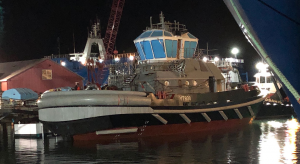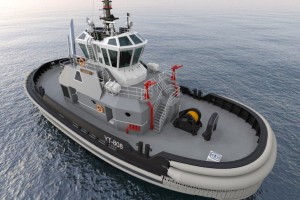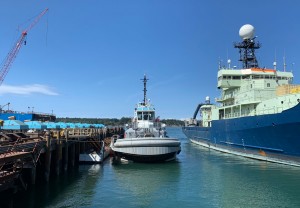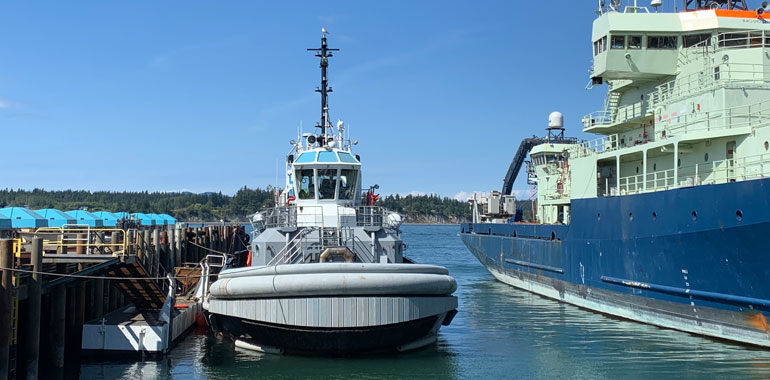
The U.S. Navy took another step toward replacing its aging yard tugboats with the launch of the first vessel in the YT 808 class at Dakota Creek Industries in Anacortes, Wash., in May. It follows the launch of six YT 802-class yard tugs between 2009 and 2011.
“This is an exciting milestone for this program, as the YT 808-class tugs will replace tugs built in 1964 through 1975,” said Mike Kosar, program manager of the Support Ships, Boats and Craft Program Office within Program Executive Office Ships (PEO Ships) at U.S. Naval Sea Systems Command. “With five more in the pipeline, we’re excited to get these tugs underway and operational.”
The YT 808 class will be used for towing and ship-handling duties for aircraft carriers, surface ships, submarines and barges. Acceptance trials for the initial tug in the series are scheduled for September, with delivery of the other five tugs planned for this fall through the fall of 2021, according to Dan Shimooka, principal assistant program manager of Service Craft and Seaborne Targets for PEO Ships.
The YT 808 is 90 feet long and 38 feet 3 inches wide, with a navigational draft of 16 feet 6 inches. The tug is powered by twin Caterpillar 3512E main engines, each delivering 1,810 horsepower, driving Schottel SRP 340 fixed-pitch z-drive thrusters. Bollard pull is estimated at 40 metric tons, with a top running speed of 12 knots.

The tug has two rows of cylindrical fendering and a lower course of “W” fenders at the bow, according to designer Robert Allan Ltd. (RAL) of Vancouver, British Columbia. The fire pump is capable of delivering 2,000 gallons per minute through a pair of monitors. The YT 808 also has a remote folding mast. Although it is a day boat, there are quarters for up to six crewmembers.
The initial YT 808 is the newest vessel in the Navy’s effort to modernize its tug fleet. The class will replace YTB tugboats at the Portsmouth Naval Shipyard in Maine and in the Pacific Northwest, which are between 45 and 55 years old and are difficult to maintain due to obsolete equipment, according to Shimooka.
Starting in 2009, six boats in the YT 802 class were built over a two-year period by the now-defunct J.M. Martinac Shipbuilding Corp. in Tacoma, Wash. Before that, the last new Navy yard tugs were built in 1975. The Navy still operates seven of the YTB 760-class tugs, which were built in the 1960s.
Both the YT 802 and YT 808 classes were designed by Robert Allan Ltd. The 808 class is based on the company’s Z-Tech 4500 tugs and has several new features compared to the 802. Many modifications were based on feedback from captains as well as new Navy requirements, according to the designer.
The biggest change in the YT 808 class is due to the U.S. Environmental Protection Agency’s Tier 4 emissions standards for marine diesel engines. The addition of the equipment required to comply with Tier 4 — primarily a selective catalytic reduction (SCR) system to reduce nitrogen oxide in the exhaust — meant a major redesign of the interior of the tug.
“(The SCR) units are big and bulky,” said Evan Gatehouse, project director and senior naval architect at RAL. “They are continuing to be a challenge because tugboats already have a crammed engine room. These units are almost half the volume of an engine, so finding room for them you basically need to reconfigure. … Previously it was a straightforward exhaust system.”
Adding to the challenge was the diesel exhaust fluid (DEF) for the exhaust aftertreatment. The fluid is corrosive and is usually housed in stainless-steel tanks, but it is sensitive to heat. “So you don’t want to put it in the engine room, because the heat breaks it down sooner than you’d like,” Gatehouse said. In the YT 808, two 1,000-gallon DEF tanks are located in the z-drive compartment, port and starboard. They are shaped like a trapezoid to fit tightly against the side hull frames.
Another modification from the YT 802 class involves the fendering. The 802’s side fendering was just along the sheer line, Gatehouse said, so RAL added diagonal fendering for handling low-freeboard barges. At the same time, the Navy did not want this modification to increase the drag of the tug. In the first design concept, the diagonal fendering at the stern dragged in the water, “so the most aft diagonal fendering has been chopped a bit shorter just to keep it out of the stern wave,” he said.
Fendering changes also were made to protect submarines. The Navy requested that the underwater fendering, wrapped around the skeg in the YT 802 class, be extended toward the sides of the tug in case the boat comes in at an angle to a submarine and touches it.
“These submarines are coated with those sound-absorbing tiles, and they are kind of delicate,” Gatehouse said.

The Navy requested that a single bitt aft in the YT 802 class be replaced by an H-bitt to make towing over the stern safer. The articulating hydraulic brow, used to transfer personnel to ships alongside the tug or down to submarines, also has been improved.
Other new features are a slightly larger aft hydraulic capstan for tightening lines; upgraded commercial navigation electronics and communications equipment; and more durable coatings and nonskid surfaces on deck, Shimooka said. A CCTV monitoring system also has been added.
JonRie InterTech, which supplied the deck machinery for the YT 802 class, also provided it for the YT 808 class. The tug’s bow features a JonRie Series 210 heavy-duty hawser winch with the company’s standard render block. The winch has the capacity to spool 600 feet of 7-inch hawser with a line pull of 20,000 pounds, a line speed of 175 feet per minute, and a brake capacity of 300,000 pounds.
A JonRie Series 421 heavy-duty capstan on the stern has a line pull of 15,000 pounds and a line speed of 30 feet per minute. A 75-hp hydraulic power unit in the engine room runs the winches.

